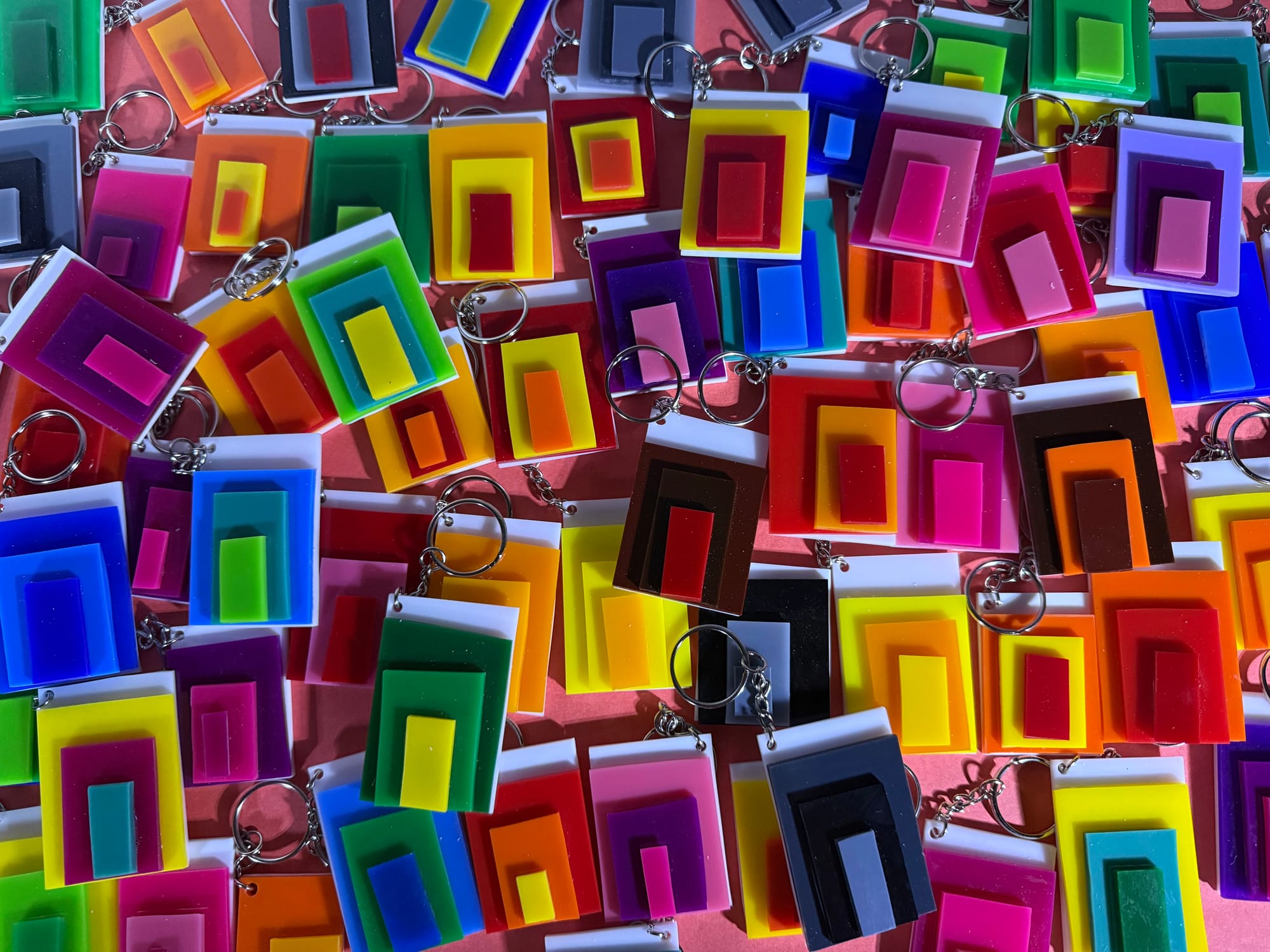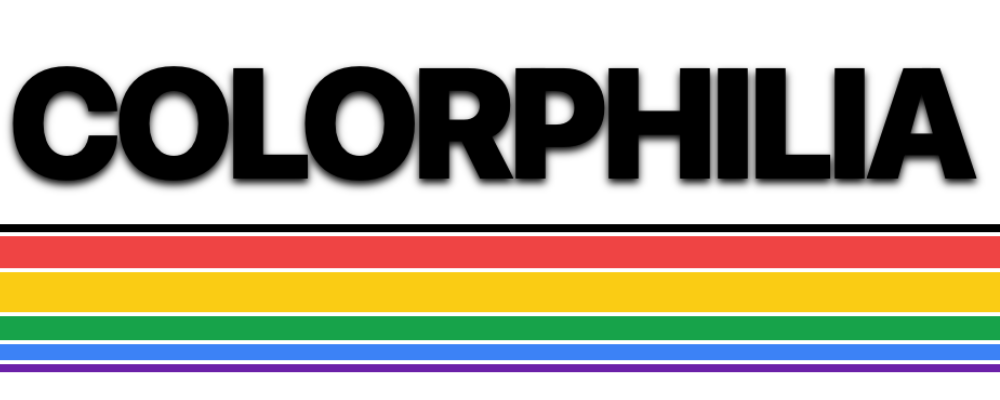Ghosting, Apparitions & Spectra
A flash sale and a reexamination of different types of spectra.

There are many unanswerable questions in the world. One of the them is "Ezra, where exactly are you moving once you leave Chicago?"
My immediate plans are to travel Europe for the next two months, visiting libraries, archives, and museums, and taking the time to revisit, organize, edit and completely rewrite many of the 60+ Colorphilia topics I've researched thus far. During the same time, I'm eager to meet with fellow advocates, purveyors, and practioners of curiosity. (Introductions and recommendations appreciated.)

An Appeal to (Incredibly Kind & Helpful) Angels
If you would like to help financially, I've created a "pay what you want" sale, which I'll ship you a unique handcut acrylic keychain from my Homage² collection, which will only be available to order for the 36 hours (until Wednesday night 6/25).
All orders will ship on Thursday 6/26.
If you prefer to use Zelle, you can send the payment to ezra@colorphilia.com. Please include your preferred color(s) and shipping address.
The first 25 or so supporters will also receive a Limited Edition Retired Colors 8-Count Crayon Pack as an additional thank you. And finally, I'll also be including a signed 1/1 "once in a blue moon" keychain as an added unique thank you to whoever helps out the most.

Perception & Reception
Over the past few months, I've worked with a new artistic medium - acrylic sheets - which I handcut into order to create a variety of things from abstract art to functional boxes. One of the things I worked on was another homage to Josef Albers, the color experimentalist and author I mentioned in the previous newsletter. He was the artist and teacher of color theory who wrote “Interactions of Color”, a book I suggest to anyone, because his method of teaching is about experimentation.
One of his well-known collections that you can find in many museums is called “Homage to the Square”. Each of the canvases us a collection of three overlaid squares in three different hues of the same color. As Cornelia Lauf wrote for the Guggenheim about his "Homage to the Square: Apparition":
It is part of a series that Albers began in 1950 and that occupied him for 25 years. The series is defined by an unmitigating adherence to one pictorial formula: the square. The optical effects Albers created—shimmering color contrasts and the illusion of receding and advancing planes—were meant not so much to deceive the eye as to challenge the viewer’s faculties of visual reception.
This shift in emphasis from perception willed by the artist to reception engineered by the viewer is the philosophical root of the Homage to the Square series. Albers tried to teach the mechanics of vision and show even the uninformed viewer how to see. He was always proud that many nonart students took his classes at Yale.
I initially wanted to call the collection “Homage to the Other Four-Angled Shapes That Josef Albers Ignored” but that felt too wordy, so I changed it to “Homage to an Homage” which sounded too repetitive, and finally to “Homage Squared” or "Homage²".
Spectra
I've been reexploring Sir Isaac Newton’s spectrum. As we saw previously, he was the likely first person to use the word spectrum with respect to color. Previous, it meant visions or ghosts (as spectre). It is derived from the Latin word for watching or observing: specio. It's not the same word we would use for simply seeing, that would be vide or video.
Linguistically, specio is related to the Greek word σκέπτομαι (skeptomai), from where we get everything from skeptic to microscope. (I would also contend that the word speck is the smallest visible item.)
As a reminder, the words telescope and microscope were originally coined in the beginning of the 17th century by the members of the Roman Accademia dei Lincei (Lincean Academy), a place where poets and scientists came together to appreciate and respect the wisdom of the past, while following their curiosity to understand the world, and create the tools and ideas to help define the future. Their most famous member was Galileo Galilei, who used the academy's inventions to prove the heliocentric nature of the the universe, much to the chagrin of the Catholic Church.
As I had previously noted multiple times, the rainbow had originally been described with 3 (or 4) colors, and Newton’s 7 colors made not sense. The 3 would be the “beginning” (or a red color), the “center” (the green or blue color), and the “end” (a purple color). We include extra colors when we recognize extra colors. As I noted about orange and indigo that those were names of specific colors to which Newton became extra attentive during his life.
But since then, the connotation of spectrum was expanded to everything imaginable, from mental health to religion to politics to sexuality.
And in exploring the word again, it has become synonymous with the range of everything inclusive within whatever the topic was. By definition, a spectrum must include everything. However, just like color, it’s often difficult to list everything. So in the pursuit of expediency, “authorities” tend define what is included within the spectrum.
Mental Health
In the case of mental health, the spectrum is generally defined by the DSM. There have been many a controversy over what should be included and excluded in the directory. There has also been a linguistic shift in considering neurodivergence to be a spectrum and not individual, discrete diagnoses.
Ironically, Hans Asperger (the Nazi whose name was used to describe a type of neurodivergence) had used his various roles to help "cleanse" the Volk of individuals he felt should not be part of society.
Religion
Similarly, in the spectrum of religion, the question of what is considered a religion and what isn’t has been debated and the stuff of lawsuits. There are real legal ramifications to what is considered to be part of the spectrum of valid religious belief, and what is a cult.
When is something considered to be a sect of one religion, and at what point does it split to something new?
While all religions may belong on a spectrum of religion, each religion is comprised of a spectrum of streams of adherents of the particular religion.
Politics
In the political spectrum, it can often take a revolution for a political idea to be accepted. When comparing the US political spectrum with equivalent European examples, for example, the latter tend to have a more densely populated political spectra, governing by coalition, because the two-party system of the US tends to obfuscate more nuanced political philosophies and beliefs.
The Overton Window, as described by Joseph Overton of the Mackinac Institute is an attempt at describing a spectrum of political and social policies as opposed to political philosophies or organizations.
The Overton Window is a model for understanding how ideas in society change over time and influence politics. The core concept is that politicians are limited in what policy ideas they can support — they generally only pursue policies that are widely accepted throughout society as legitimate policy options. These policies lie inside the Overton Window. Other policy ideas exist, but politicians risk losing popular support if they champion these ideas. These policies lie outside the Overton Window.
In other words, the Overton Window represents the visible part of the legitimate political spectrum.
Sexuality and Gender Identity
And the symbol of LGBTQIA+ is literally a rainbow, the original subject of Newton’s spectrum. As I’ve mentioned, the original flag only had 6 stripes, but over the past decades, colors not traditionally included in the spectrum of light have been included in the flag.
Alfred Kinsey's fluid spectrum (or scale) of functional sexuality includes 7 levels ranging from fully heterosexual to the fully homosexual, with equally bisexual in the center. He used X to describe asexuality, however, I would contend that as asexuality is visually unobservable by the nature of being unable to describe the abscence.
Therefore, it is not by accident that the term "visibility" is used so often in the LGBTQIA+ vernacular, because the spectrum, by definition, only includes things that can be observed. If something is unobservable, an actively or explicitly stated self-identity would fill the same function.
Spectrum of Spectra
A spectrum is invented metaphor to categorize and group together loosely related ideas. The two ends of the spectrum tend to have a lot in common with each other, more than they necessarily have with the center.
Just like color, Albers' distinction of Perception versus Reception can be applied to many other spectra as well. Everything along the spectrum should be equally valid (as existing), as it is used to describe what can be observed.
Just because one doesn't agree with a political philosophy or doesn't identify with a specific sexual identity doesn't mean that it does not exist. It simply means that they are elsewhere on the spectrum.
Inclusion or exclusion from the spectrum should theoretically not be a value judgement, but extending Albers' distinction, it always is. And the Reception tends to assign a positive or negative valence to certain items on the spectrum, which tend to be based on the location of the viewer on the particular spectrum.
Paradoxically enough, according to Al Baumgarten's "Law of the Martian", the Receptive animus between the bands of the spectrum is going to be highest the closer they are. To use the color spectrum as an example, a light green is going to sometimes be perceived as yellow and other times as green, and will harbor negativity from both the yellow and the green as being an outsider.
